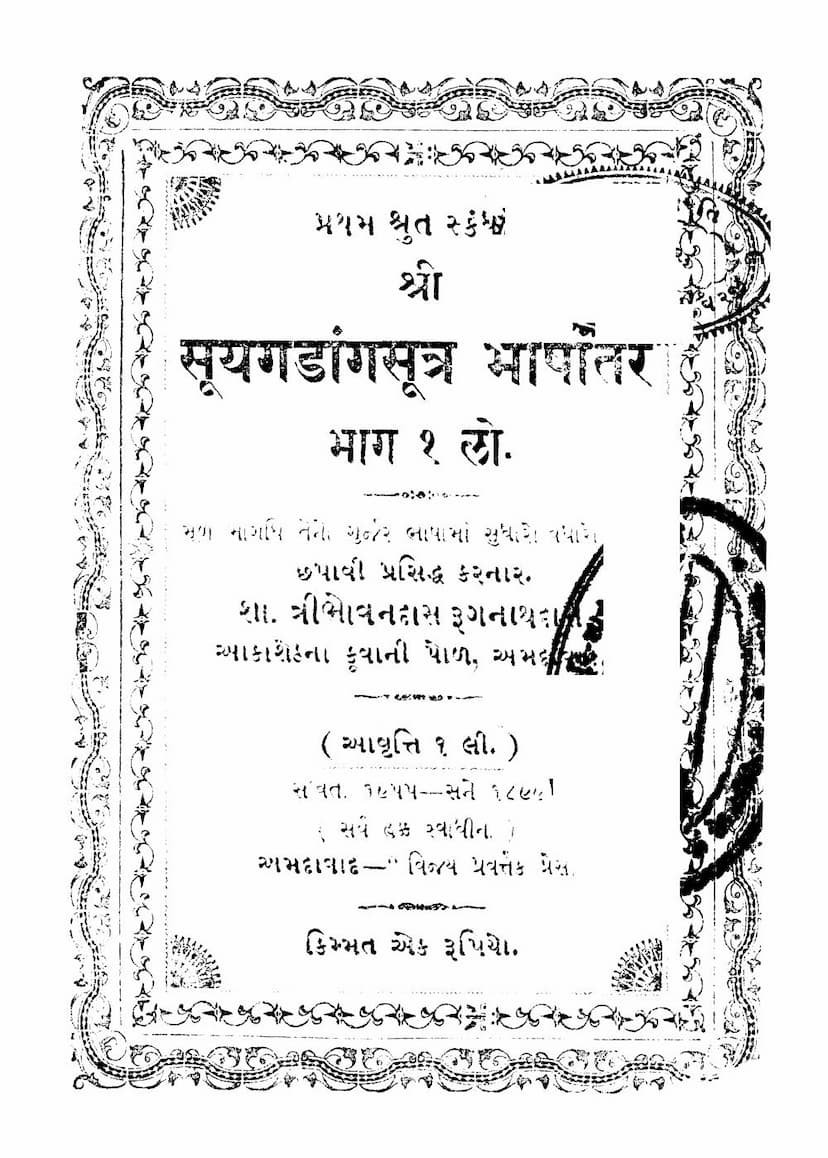Suyagadanga Sutra Bhashantar Part 01
Added to library: September 2, 2025

Summary
This is a summary of the Gujarati text you provided, which appears to be an introduction and table of contents for the Suyagadanga Sutra Bhashantar, Part 01, translated or compiled by Tribhovandas Rugnathdas Shah. The text is in Gujarati.
Book Title: Suyagadanga Sutra Bhashantar Part 01 Author: Tribhovandas Rugnathdas Shah Publisher: Tribhovandas Rugnathdas Shah Catalog Link: https://jainqq.org/explore/023494/1
Summary:
The provided text is the first part of a Gujarati commentary (Bhashantar) on the Suyagadanga Sutra, which is considered the second Anga (limb or chapter) of the Jain Agamas (canonical scriptures). The publication aims to make the profound teachings of Jainism accessible to a wider audience.
Key points from the text:
-
Purpose of the Publication (Page 3-5): The introduction emphasizes that in this transient world, only religion (Dharma) can liberate beings from the cycle of birth, death, and suffering. The essence of Dharma is found in compassion (Daya). While many philosophical schools acknowledge compassion, only the Jain philosophy fully embraces and practices it in its entirety, making it the foremost among them. The introduction draws an analogy to cooking, where all essential ingredients must be present for the dish to be palatable; similarly, true Dharma requires the complete practice of compassion. The text explains that various types of compassion are detailed in Jain scriptures (e.g., self-compassion, compassion for others, material compassion, mental compassion, ultimate and conventional compassion), which are not fully understood by other traditions. The author states that the original Jain principles are in a language difficult for many to grasp, and this translation aims to bridge that gap, allowing all to benefit from the philosophical depth. It also aims to support those who may not have access to learned monks for guidance.
-
Copyright Notice (Page 2): The publisher, Tribhovandas Rugnathdas Shah, asserts their copyright for printing and publishing the book, as registered under the Act of 1867. Unauthorized reproduction is prohibited.
-
List of Books Available (Page 2): The publisher also announces that a detailed list of books available at their Jain library is printed separately and invites interested individuals to request it.
-
Table of Contents (Page 6): The table of contents lists the chapters (Adhyayan) and sections (Udesha) covered in this first part of the translation. It includes:
- Adhyayan 1: Udesha 1, 2, 3, and 4
- Adhyayan 2: Udesha 1, 2, and 3
- Adhyayan 3: Udesha 1, 2, 3, and 4
- Adhyayan 4: Udesha 1 and 2
- Adhyayan 5: Udesha 1 and 2
- Adhyayan 6: Title: Sri Virastuti (Praise of Mahavir)
- Adhyayan 7: Title: Narayavibhaktinirakarnanam (Refutation of Narayana's views)
- Adhyayan 8: Title: Virya (Strength/Energy)
- Adhyayan 9: Title: Dharma (Righteousness/Duty)
- Adhyayan 10: Title: Samadhi (Concentration/Peace)
- Adhyayan 11: Title: Moksha Marg (Path to Liberation)
- Adhyayan 12: Title: Samavasharana (The Assembly/Discours)
- Adhyayan 13: Title: Yathatathya (Reality/Truth)
- Adhyayan 14: Title: Granth Parityag (Renunciation of Possessions)
- Adhyayan 15: Title: Adan (Acceptance/Taking)
- Adhyayan 16: Title: Gaha (Verse/Saying)
-
Content of the Commentary (Page 7 onwards): The commentary begins by establishing the connection between the Acharya Sutra and the Suyagadanga Sutra. It then delves into the Jain perspective on liberation, stating that it is achieved through both knowledge (Jnana) and action (Kriya), contrasting this with other schools that emphasize only one aspect. The text then proceeds to discuss the causes of bondage (Bandhana), which are identified as attachment (Parigrah) and involvement in activities that harm living beings (Arambh). It explains how these lead to the accumulation of karma. The commentary also includes extensive discussions and refutations of various philosophical views held by other contemporary schools of thought, such as Charvaka (materialists), Sankhya, Bauddha (different interpretations), and others, often addressing their understanding of the soul, karma, causation, and the nature of reality. The initial sections focus on the dangers of attachment, the importance of right conduct, and the refutation of false doctrines. The detailed breakdown of chapters covers various aspects of Jain ethics, philosophy, and the path to liberation, including discussions on different types of hellish punishments, the qualities of an ideal monk, the refutation of other spiritual paths, and the importance of virtuous conduct and mental equanimity.
In essence, this volume serves as an introductory guide and commentary to the Suyagadanga Sutra, aiming to elucidate its core teachings on compassion, the causes of suffering, the refutation of erroneous philosophies, and the Jain path to spiritual liberation, emphasizing the integration of knowledge and practice.